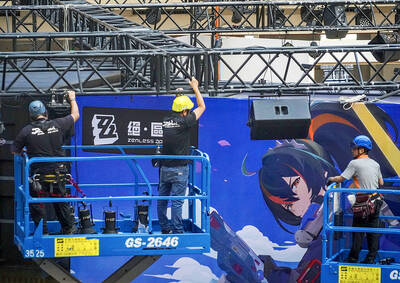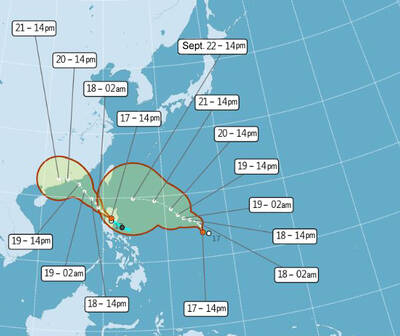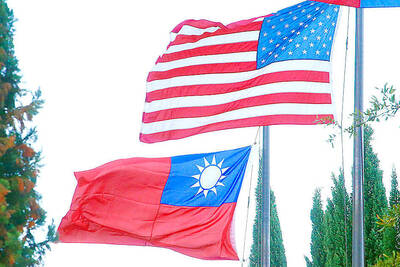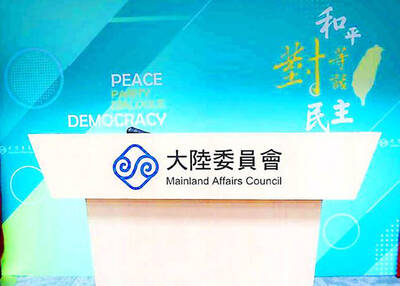The operator of Japan’s stricken Fukushima Dai-ichi nuclear power plant yesterday said it had found highly radioactive water dripping from a pipe connecting two coolant tanks at one of four radiation hotspots.
The discovery came hours after Tokyo Electric Power Co (TEPCO) said late on Saturday that radioactivity at one of the other four sites measured 1,800 millisieverts per hour — a dose that would kill a human exposed to it in four hours.
The reading was 18 times higher than a recording at the same place taken on Aug. 22, although the company said the first measurement was done with equipment that could only reach up to 100 millisieverts.
A TEPCO spokesman said the radiation of 1,800 millisieverts was largely beta ray with weak penetration force, which workers can easily block by wearing protective jackets.
TEPCO has long struggled to deal with the huge amounts of water used to cool reactors that went into meltdown after being struck by an earthquake and tsunami in 2011.
The government has promised to get more involved in the plant’s cleanup after TEPCO’s efforts came in for fierce criticism.
The leaking pipe was found to be dripping one drop about every 90 seconds, the company said.
Workers tightened 12 bolts to stop the leak and bolstered the repair using special material and plastic tape.
Water with a radioactivity of 230 millisieverts per hour was found below it, the operator said, while at two other hotspots near tanks, workers also measured radioactivity of 70 and 220 millisieverts per hour. The fourth hotspot measured 1,800. Two of the sites, including where the pipe was dripping, were completely new discoveries, while at the other two sites, the readings were considerably higher than previously measured.
“We have to suspect that the high radiation levels were detected due to toxic water oozing out of the flange connections,” the spokesman said, adding that the company has not yet come to a conclusion.
Last week, the plant operator admitted that 300 tonnes of toxic water had leaked from one large tank — one of about 1,000 on the site — before anyone had noticed.
The spill sparked fears the toxic water may have seeped into the ocean. It was categorized as a Level 3 event, the most serious category since the meltdown itself.
In response to growing domestic and international criticism of TEPCO’s handling of the crisis, Japanese Prime Minister Shinzo Abe on Thursday promised the world his government would play a greater role in stopping leaks of highly radioactive water.

Taiwan is projected to lose a working-age population of about 6.67 million people in two waves of retirement in the coming years, as the nation confronts accelerating demographic decline and a shortage of younger workers to take their place, the Ministry of the Interior said. Taiwan experienced its largest baby boom between 1958 and 1966, when the population grew by 3.78 million, followed by a second surge of 2.89 million between 1976 and 1982, ministry data showed. In 2023, the first of those baby boom generations — those born in the late 1950s and early 1960s — began to enter retirement, triggering

One of two tropical depressions that formed off Taiwan yesterday morning could turn into a moderate typhoon by the weekend, the Central Weather Administration (CWA) said yesterday. Tropical Depression No. 21 formed at 8am about 1,850km off the southeast coast, CWA forecaster Lee Meng-hsuan (李孟軒) said. The weather system is expected to move northwest as it builds momentum, possibly intensifying this weekend into a typhoon, which would be called Mitag, Lee said. The radius of the storm is expected to reach almost 200km, she said. It is forecast to approach the southeast of Taiwan on Monday next week and pass through the Bashi Channel

NO CHANGE: The TRA makes clear that the US does not consider the status of Taiwan to have been determined by WWII-era documents, a former AIT deputy director said The American Institute in Taiwan’s (AIT) comments that World War-II era documents do not determine Taiwan’s political status accurately conveyed the US’ stance, the US Department of State said. An AIT spokesperson on Saturday said that a Chinese official mischaracterized World War II-era documents as stating that Taiwan was ceded to the China. The remarks from the US’ de facto embassy in Taiwan drew criticism from the Ma Ying-jeou Foundation, whose director said the comments put Taiwan in danger. The Chinese-language United Daily News yesterday reported that a US State Department spokesperson confirmed the AIT’s position. They added that the US would continue to

The number of Chinese spouses applying for dependent residency as well as long-term residency in Taiwan has decreased, the Mainland Affairs Council said yesterday, adding that the reduction of Chinese spouses staying or living in Taiwan is only one facet reflecting the general decrease in the number of people willing to get married in Taiwan. The number of Chinese spouses applying for dependent residency last year was 7,123, down by 2,931, or 29.15 percent, from the previous year. The same census showed that the number of Chinese spouses applying for long-term residency and receiving approval last year stood at 2,973, down 1,520,